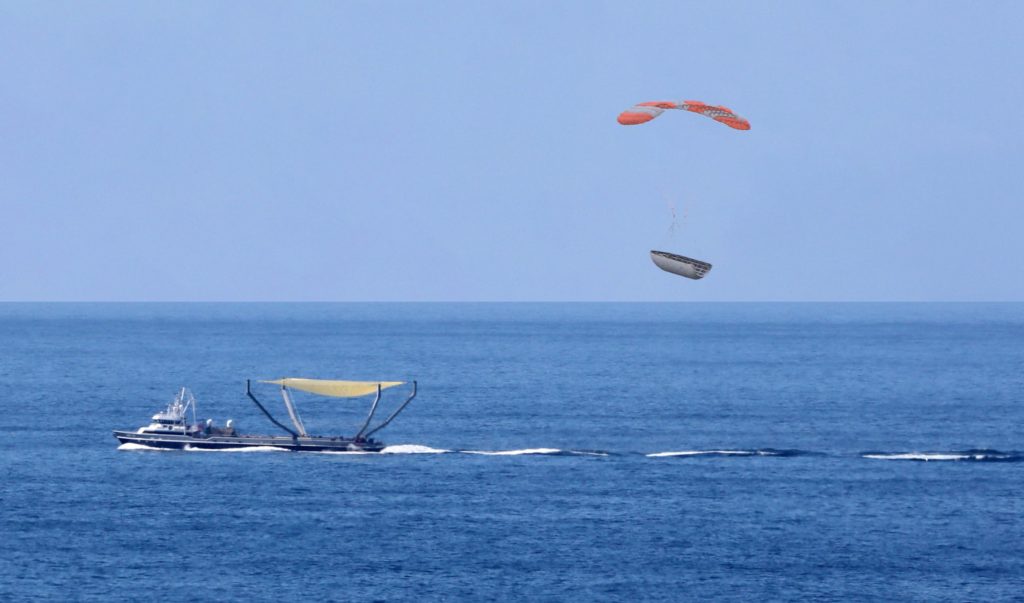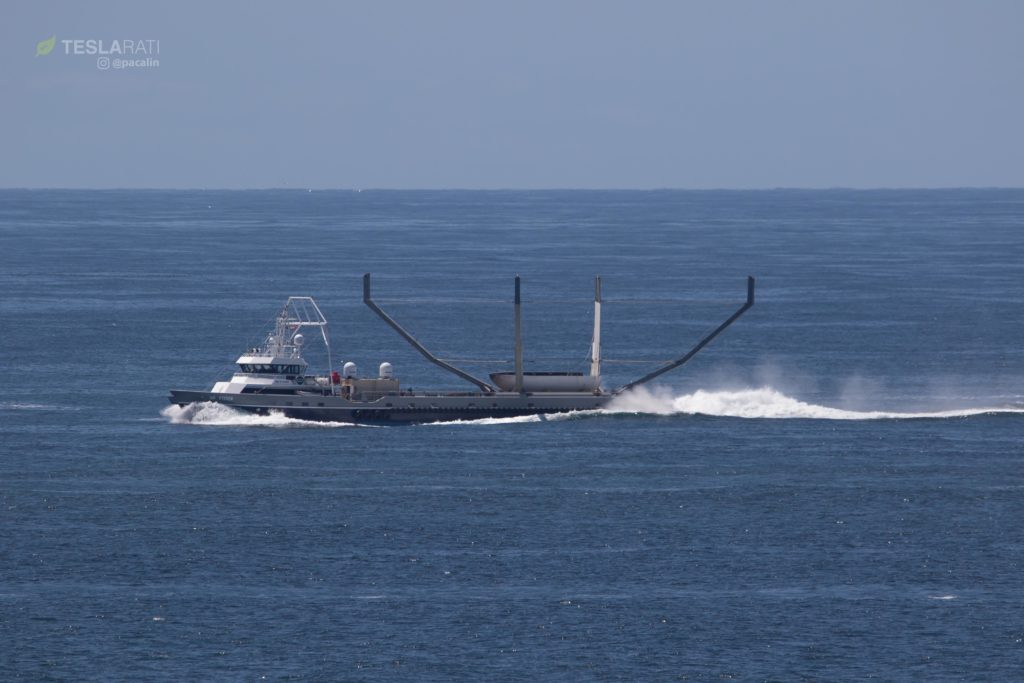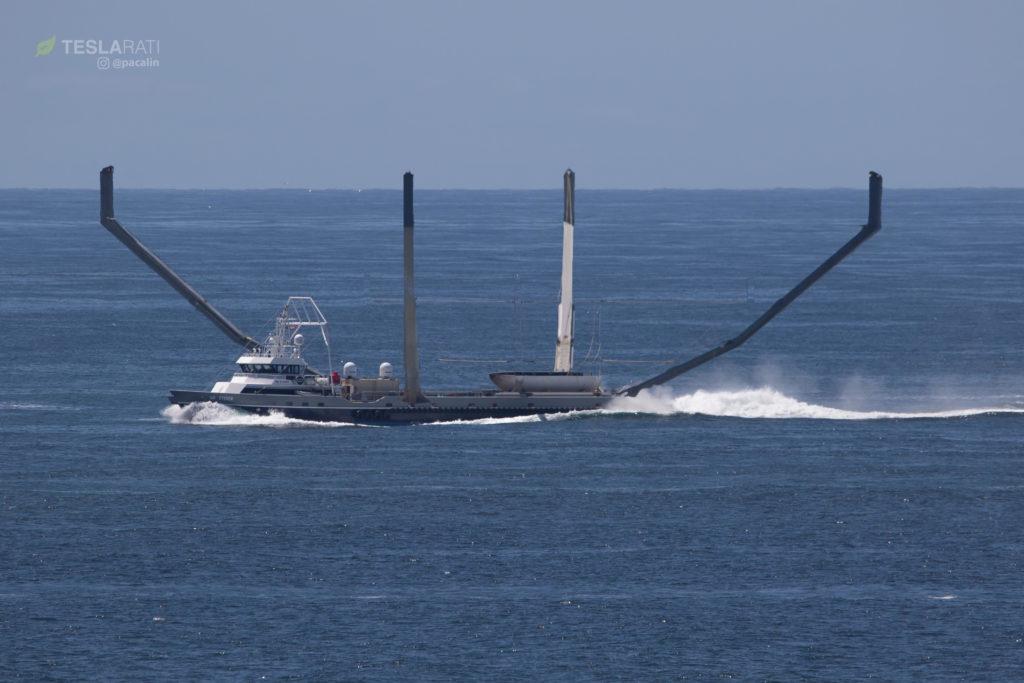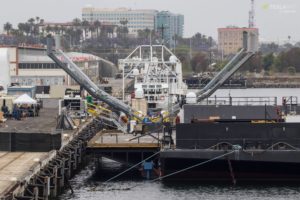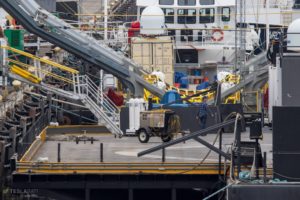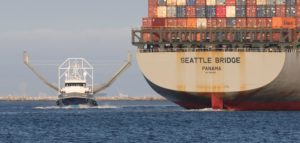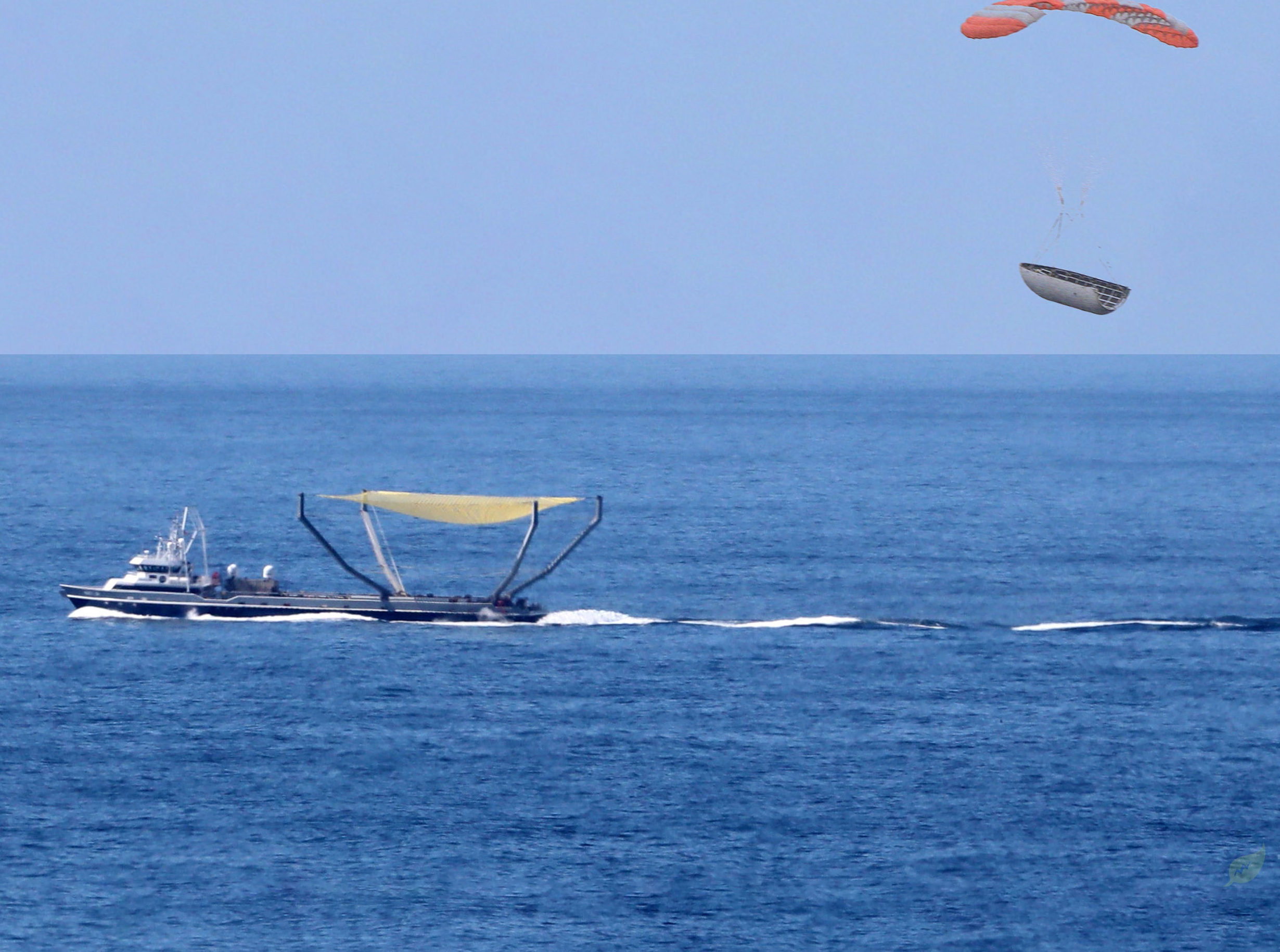

News
SpaceX’s first fairing catch imminent with plans to 4X Mr Steven’s net
Following SpaceX CEO Elon Musk’s brief confirmation that the launch company would be quadrupling recovery vessel Mr Steven’s already-huge net, members of the /r/SpaceX subreddit created a rough visualization of what that expanded net might look like once completed.
Based on rough estimates done by the author, SpaceX’s official confirmation that fairings had landed within 50 meters of Mr Steven’s net indicates that the parasailing halves are able to somewhat reliably reach Mr Steven’s net with a margin of error of roughly 0.01% when they really need 0.005% to be caught in the vessel’s net every time. Based on specifications from the vessel’s shipyard, his current claws appear to be roughly 75% the length of the entire vessel, or something like 40m long by 30 to 40m wide.
- An artist rendering of a Falcon 9 fairing parasailing towards Mr Steven’s net. Original photos by Chuck Bennett (Instagram @chuckbennett) and SpaceX. (/Chuck Bennet/SpaceX/Eric Ralph)
- It’s difficult to imagine how Mr Steven’s already vast net could plausibly be expanded by a factor of two in each dimension. I certainly can’t wait to see how SpaceX engineers and technicians tackle the task. (Pauline Acalin)
- Created by Reddit /u/Pipinpadiloxacopolis, this visualization shows Mr Steven with net with 4X the area currently installed. (Teslarati/ /u/Pipinpadiloxacopolis)
Several days after the author’s speculation was published, Mr. Musk appeared to effectively corroborate it by stating on Twitter that Mr Steven’s net would have its area expanded fourfold in order to operationalize fairing recovery: to quadruple the area, both the length and the width of the net would need to be expanded by a factor of two (square) or perhaps 50% width-wise and 150% lengthwise (more rectangular). Mr Steven’s massive steel arms appear to be fairly permanent in their current forms, suggesting that changing the aspect ratio of the net would be far more effort than simply expanding his arms along their current paths. Either way, lengthwise growth of a factor of 2-2.5 would appear to functionally close the gap on that 0.005% margin of error (the current 0.01% – missing by 50 meters – divided by 2 equals 0.005%) required, albeit by modifying the recovery vessel instead of optimizing the fairings’ hardware and software.
TL;DR: @SpaceX's fairing recovery engineers/techs have achieved a margin of error of like 0.01% when they actually need ~0.005% to reliably catch fairings in Mr Steven's net. Success is imminent 😀 https://t.co/MfPdzdBkyO
— Eric Ralph (@13ericralph31) June 1, 2018
Put more simply, a net with four times the area would roughly halve the accuracy required from each fairing half for reliable recovery. Compared with the original (left) above, Reddit user Pipinpadiloxacopolis followed Musk’s rough estimation and did a rough Photoshop (right) of the fairing recovery vessel’s current arms, expanding it by 2X in each direction to arrive at a quadrupled area. Although I would argue that Mr Steven’s forward arms are unlikely to ever move beyond their current end-point around 10 meters behind the vessel’s crew cabin and cockpit, /u/Pipin’s estimate is probably a decent prediction for the upgraded vessel’s most likely appearance.
What’s less clear is whether the depth of the net will increase alongside the length and width, nor whether the already massive arms will have to rely on some sort of retraction/pivot mechanism to allow Mr Steven to safely maneuver within Port of Los Angeles waters. Regardless of the solution that SpaceX expertise arrives at, the already eclectic recovery vessel is all but guaranteed to look even more absurd and awesome than it already does. With any luck, the net expansion may allow SpaceX to finally achieve their first successful ‘catch’ of a Falcon fairing, ending the need for mass-storage of unreusable fairing halves grabbed off of the ocean surface.
- Mr Steven and drone ship Just Read The Instructions captured at their berths on June 5th. JRTI also appears to be preparing for a return to action with Iridium-7. (Pauline Acalin)
- Even SpaceXers deserve a break. (Pauline Acalin)
- Mr Steven slips between massive container ship canyons on the final leg of its return. (Chuck Bennett, Instagram @chuckbennett)
Stay tuned, as Teslarati photographer Pauline Acalin will be tracking modifications made to Mr Steven closely over the next several weeks. As of now, the vessel will return to the Pacific Ocean for another fairing catch attempt sometime in the second or third week of July. We’ll find out soon whether Musk’s mentioned upgrades can be realized before then.

News
Elon Musk’s Grokipedia surges to 5.6M articles, almost 79% of English Wikipedia
The explosive growth marks a major milestone for the AI-powered online encyclopedia, which was launched by Elon Musk’s xAI just months ago.

Elon Musk’s Grokipedia has grown to an impressive 5,615,201 articles as of today, closing in on 79% of the English Wikipedia’s current total of 7,119,376 articles.
The explosive growth marks a major milestone for the AI-powered online encyclopedia, which was launched by Elon Musk’s xAI just months ago. Needless to say, it would only be a matter of time before Grokipedia exceeds English Wikipedia in sheer volume.
Grokipedia’s rapid growth
xAI’s vision for Grokipedia emphasizes neutrality, while Grok’s reasoning capabilities allow for fast drafting and fact-checking. When Elon Musk announced the initiative in late September 2025, he noted that Grokipedia would be an improvement to Wikipedia because it would be designed to avoid bias.
At the time, Musk noted that Grokipedia “is a necessary step towards the xAI goal of understanding the Universe.”
Grokipedia was launched in late October, and while xAI was careful to list it only as Version 0.1 at the time, the online encyclopedia immediately earned praise. Wikipedia co-founder Larry Sanger highlighted the project’s innovative approach, noting how it leverages AI to fill knowledge gaps and enable rapid updates. Netizens also observed how Grokipedia tends to present articles in a more objective manner compared to Wikipedia, which is edited by humans.
Elon Musk’s ambitious plans
With 5,615,201 total articles, Grokipedia has now grown to almost 79% of English Wikipedia’s article base. This is incredibly quick, though Grokipedia remains text-only for now. xAI, for its part, has now updated the online encyclopedia’s iteration to v0.2.
Elon Musk has shared bold ideas for Grokipedia, including sending a record of the entire knowledge base to space as part of xAI’s mission to preserve and expand human understanding. At some point, Musk stated that Grokipedia will be renamed to Encyclopedia Galactica, and it will be sent to the cosmos.
“When Grokipedia is good enough (long way to go), we will change the name to Encyclopedia Galactica. It will be an open source distillation of all knowledge, including audio, images and video. Join xAI to help build the sci-fi version of the Library of Alexandria!” Musk wrote, adding in a later post that “Copies will be etched in stone and sent to the Moon, Mars and beyond. This time, it will not be lost.”
News
Tesla Model 3 becomes Netherlands’ best-selling used EV in 2025
More than one in ten second-hand electric cars sold in the country last year was a Tesla Model 3.

The Tesla Model 3 became the most popular used electric car in the Netherlands in 2025, cementing its dominance well beyond the country’s new-car market.
After years at the top of Dutch EV sales charts, the Model 3 now leads the country’s second-hand EV market by a wide margin, as record used-car purchases pushed electric vehicles further into the mainstream.
Model 3 takes a commanding lead
The Netherlands recorded more than 2.1 million used car sales last year, the highest level on record. Of those, roughly 4.8%, or about 102,000 vehicles, were electric. Within that growing segment, the Tesla Model 3 stood far ahead of its competitors.
In 2025 alone, 11,338 used Model 3s changed hands, giving the car an 11.1% share of the country’s entire used EV market. That means more than one in ten second-hand electric cars sold in the country last year was a Tesla Model 3, Auto Week Netherlands reported. The scale of its lead is striking: the gap between the Model 3 and the second-place finisher, the Volkswagen ID3, is more than 6,700 vehicles.
Rivals trail as residual values shape rankings
The Volkswagen ID.3 ranked a distant second, with 4,595 used units sold and a 4.5% market share. Close behind was the Audi e-tron, which placed third with 4,236 registrations. As noted by Auto Week Netherlands, relatively low residual values likely boosted the e-tron’s appeal in the used market, despite its higher original price.
Other strong performers included the Kia Niro, the Tesla Model Y, and the Hyundai Kona, highlighting continued demand for compact and midsize electric vehicles with proven range and reliability. No other model, however, came close to matching the Model 3’s scale or market presence.
News
Tesla Model Y Standard Long Range RWD launches in Europe
The update was announced by Tesla Europe & Middle East in a post on its official social media account on X.

Tesla has expanded the Model Y lineup in Europe with the introduction of the Standard Long Range RWD variant, which offers an impressive 657 km of WLTP range.
The update was announced by Tesla Europe & Middle East in a post on its official social media account on X.
Model Y Standard Long Range RWD Details
Tesla Europe & Middle East highlighted some of the Model Y Standard Long Range RWD’s most notable specs, from its 657 km of WLTP range to its 2,118 liters of cargo volume. More importantly, Tesla also noted that the newly released variant only consumes 12.7 kWh per 100 km, making it the most efficient Model Y to date.
The Model Y Standard provides a lower entry point for consumers who wish to enter the Tesla ecosystem at the lowest possible price. While the Model 3 Standard is still more affordable, some consumers might prefer the Model Y Standard due to its larger size and crossover form factor. The fact that the Model Y Standard is equipped with Tesla’s AI4 computer also makes it ready for FSD’s eventual rollout to the region.
Top Gear’s Model Y Standard review
Top Gear‘s recent review of the Tesla Model Y Standard highlighted some of the vehicle’s most notable features, such as its impressive real-world range, stellar infotainment system, and spacious interior. As per the publication, the Model Y Standard still retains a lot of what makes Tesla’s vehicles well-rounded, even if it’s been equipped with a simplified interior.
Top Gear compared the Model Y Standard to its rivals in the same segment. “The introduction of the Standard trim brings the Model Y in line with the entry price of most of its closest competition. In fact, it’s actually cheaper than a Peugeot e-3008 and costs £5k less than an entry-level Audi Q4 e-tron. It also makes the Ford Mustang Mach-E look a little short with its higher entry price and worse range,” the publication wrote.
